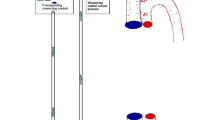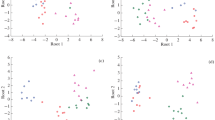Abstract
Cerebal ischemia induced by bilateral common carotid artery occlusion (15min) with and without release (1 hr) served as a model for comparative regional studies of synaptosomal 3H-5-hydroxytryptamine (3H-5-HT) uptake and release in adult and young gerbils. A decreased uptake and an increased release of 5-HT was observed in the adult after ischemia alone and/or ischemia with reflow. At the same time, 5-HT uptake was not affected except in the cortex and the release was reduced in the young. These findings indicate that the same ischemic insults affect differently the synaptosomal uptake and/or release of 5-HT in adult and young brain.
Similar content being viewed by others
References
Blomqvist, P., Lindvall, O., Stenevi, U., and Wieloch, T. (1985). Cyclic AMP concentrations in rat neocortex and hippocampus during and following incomplete ischemia: Effect of central noradrenergic neurons, prostaglandins.J. Neurochem. 44: 1345–1353.
Booth, R. F. F., and Clark, J. B. (1978). A rapid method for preparation of relatively pure metabolically competent synaptosomes from rat brain.J. Biol. Chem. 176: 365–370.
Cvejic, V., Micic, D. V., Djuricic, B. M., Mrsulja, B. J., and Mrsulja, B. B. (1980). Monoamines and related enzymes in cerebral cortex and basal ganglia following transient ischemia in gerbils.Acta Neuropathol. 51: 71–77.
Hedner, T. (1978). Central monoamine metabolism and neonatal oxygen deprivation. An experimental study in the rat brain.Acta Physiol. Scand. Suppl. 460: 3–34.
Himwich, W. A. (1976). Cerebral metabolism during growth of mammals. In Himwich, H. E. (ed.).Brain Metabolism and Cerebral Disorders, Spectrum, New York, pp. 65–87.
Karki, N., Kuntzman, R., and Brodie, B. B. (1962). Storage, synthesis and metabolism of monoamines in the developing brain.J. Neurochem. 9: 53–58.
Kogure, K., Scheinberg, P., Matsumoto, A., Busto, R., and Reinmuth, O. (1975). Catecholamines and experimental ischemia.Arch Neurol. 32: 21–24.
Kuhar, M. J., Roth, L. H., and Aghajanian (1972). Synaptosomes from forebrains of rats with midbrain raphe lesions; Selective reduction of serotonin uptake.J. Pharmacol. Exp. Ther. 181: 36–45.
Kumami, K., Mrsulja, B. B., Ueki, Y., Djuricic, D., and Spatz, M. (1989). Effect of ischemia of noradrenergic and energy-related metabolites in cerebral cortex of young and adult gerbils.Metab. Brain Dis. 3: 273–277.
Lavyne, M., Moskovitz, M. A., Larin, F., Zervas, N., and Wurtman, R. J. (1975). Brain3H-catecholamine metabolism in experimental cerebral ischemia.Neurology 25: 483–485.
Lowry, O. H., Rosebrough, N. J., Farr, A. L., and Randall, R. L. (1951). Protein measurement with the Folin phenol reagent.J. Biol. Chem. 193: 265–275.
Martinez, H., Micic, B. V., Stojanovic, T., and Spatz, M. (1985). Cerebral blood flow, energy utilization, serotonin metabolism, (Na, K) ATPase activity and post-ischemic brain swelling. In Inaba, Y., Klatzo, I., and Sptaz, M. (eds.),Brain Edema, Springer Verlag, Berlin, Heidelberg, New York, Tokyo, pp. 170–177.
Matsumoto, M., Kimura, K., Fujisawa, A., Matsuyama, T., Fukanaga, R., Yoneda, S., Wada, H., and Hiroshi, A. (1984). Differential effect of cerebral ischemia on monoamine content of discrete brain regions of the mongolian gerbil: Meriones unquiculatus.J. Neurochem. 42: 647–651.
Matsuyama, T., Matsumoto, M., Fujisawa, A., Handa, N., Tanaka, K., Yoneda, S., Kimura, K., and Abe, H. (1983). Why are infant gerbils more resistant than adult to cerebral infarction after carotid occlusion.J. Cereb. Blood Flow Metal. 3: 381–385.
Mrsulja, B. B., Mrsulja, B. J., Spatz, M., and Klatzo, I. (1976). Catecholamines in brain ischemia-effects of methyl-p-tyrosine and pargyline.Brain Res. 104: 373–378.
Mrsulja, B. B., Djuricic, B. M., Cvejic, V., Mrsulja, B. J., Spatz, M., and Klatzo, I. (1980). Biochemistry of experimental ischemic brain edema.Adv. Neural. 28: 217–230.
Mrsulja, B. B., Djuricic, B. M., Ueki, Y., Lust, W. D., and Spatz, M. (1989). Cerebral ischemia: Changes in monoamines are independent of energy metabolism.Neurochem. Res. 14: 1–7.
Payan, H. M., and Conrad, J. R. (1977). Carotid ligation in gerbils: influence of age, sex and gonads.Stroke 8: 194–196.
Spatz, M., Ueki, Y., Djuricic, B. M., and Mrsulja, B. B. (1985). 5-Hydroxytryptamine in cerebral cortex of adult and young ischemic gerbils. In Meyer, J. S., Lechner, H., Reivich, M., and Otto, E. O. (eds.).Cerebral Vascular Disease 5, Exp. Med., Amsterdam, pp. 254–259.
Strong, A. J., Tomlinson, B. E., Venables, G. S., Gibson, G., and Hardy, J. A. (1983). The cortical ischemic penumbra associated with occlusion of the middle cerebral artery in cat. 2. Studies of histopathology, water content andin vitro neurotransmitter uptake.J. Cereb. Blood Flow Metal. 3: 97–108.
Villacara, A., Kumami, K., Yamamoto, T., Mrsulja, B. B., and Spatz, M. (1989). Ischemic modification of cerebrocortical membranes: 5-HT receptors, fluidity and induciblein vitro lipid peroxidation.J. Neurochem. 53: 595–601.
Weinberger, J., and Cohen, G. (1982). The differential effect of ischemia on the active uptake of dopamine, γ-aminoburyric acid, and glutamate by brain synaptosomes.J. Neurochem. 38: 963–968.
Welch, K. M. A., Chabi, E., Dodson, R. F., Wang, T.-P. F., Nell, J., and Bergin, B. (1976). The role of biogenic amines in the progression of cerebral ischemia and edema: Modification by p-chlorphenylalnine, methysergide and pentoxyfilline. In Pappius, H., and Feindel, W. (eds.),Dynamics of Brain Edema, Springer Verlag, Berling, Heidelberg, New York, pp. 193–202.
Zervas, N. T., Hori, H., Negora, M., Wurtman, R., Larin, F., and Lavyne, M. (1974). Reduction in brain dopamine following experimental ischemia.Nature 247: 283–284.
Author information
Authors and Affiliations
Rights and permissions
About this article
Cite this article
Cvejic, V., Kumami, K. & Spatz, M. Effect of cerebral ischemia on synaptosomal uptake and release of3H-5-hydroxytryptamine in adult and young mongolian gerbils. Metab Brain Dis 5, 1–6 (1990). https://doi.org/10.1007/BF00996973
Received:
Accepted:
Issue Date:
DOI: https://doi.org/10.1007/BF00996973




